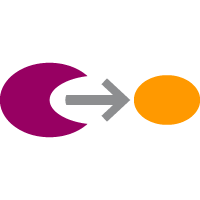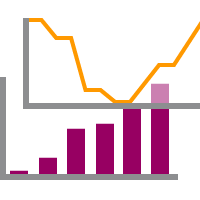ProteoTuner technology overview
Rapid, precise control of protein levels
When investigating complicated questions, a streamlined approach often yields the best results. Having the right tools enables you to make the most of every experiment, including those that seek to explore the intricate world of protein function.
Understanding the biological role of a protein is best accomplished by removing it and then studying the consequences: the loss or gain of various cellular functions. There are many well-established methods for removing proteins, including gene knockdown, the use of Cre-lox technology for gene inactivation, mutations that alter gene function, RNA interference, and various inducible transcription systems. However, all of these approaches target gene function at the DNA and mRNA levels, and most require considerable set-up time. In contrast, ProteoTuner systems allow quick, predictable regulation of protein presence or absence by acting directly on the protein, using a small, cell-permeable synthetic compound. This post-translational regulation offers a number of benefits, from speed and convenience to precise tuning and reversible control.
In this system, a protein of interest is tagged with the destabilization domain (DD), which is stable in the presence of the Shield1 ligand. Thus, a fusion protein can accumulate and be detected by various assays. Removal of the ligand destabilizes the fusion protein and leads to proteolysis.
 Mechanism overview
Mechanism overview
| Features of ProteoTuner systems | ||
|---|---|---|
| Features | Benefits | Notes |
| Rapid kinetics | When Shield1 is added to the medium, the DD-fusion protein can accumulate to detectable levels within 15–20 minutes. Conversely, upon Shield1 removal, the half-time for the protein's degradation can be as short as 30 minutes. | ProteoTuner controls the protein level by acting directly on the protein, unlike other systems that act either at the transcriptional (inducible gene expression systems) or translational level (RNA interference). |
| Precise tuning | Reduce or increase protein level as needed by decreasing or increasing the concentration of Shield1. | |
| Reversible control | Do multiple experiments on the same cells to generate statistically significant data. Easily confirm data. | Protein level is ligand-dependent. You can repeat experiments multiple times by simply removing or adding Shield1. |
| Single-vector system | Make just one fusion construct:
|
|
The ProteoTuner mechanism
ProteoTuner technology is based on a destabilizing domain (DD) that can confer its instability to a fused protein of interest. This destabilization can be rescued in a reversible and dose-dependent manner with the addition of a small molecule specific to the DD, Shield1. The definitive mechanism of DD regulation is not fully understood, although it is known that cytoplasmic DD degradation is mediated by the ubiquitin-proteasome system (Egeler et al. 2011).
Reference
Egeler, E. L., Urner, L. M., Rakhit, R., Liu, C. W. & Wandless, T. J. Ligand-switchable substrates for a ubiquitin-proteasome system. J. Biol. Chem. 286, 31328-36 (2011).
 Two core elements—DD and Shield1
Two core elements—DD and Shield1
The genetic fusion of the DD to the gene of interest ensures the specificity of the ProteoTuner system, while small-molecule control via Shield1 confers reversibility and dose-dependence on protein stability and function.
Destabilizing domain
The destabilizing domain (DD) is mutant L106P of FKBP12 (12 kD), which is rapidly degraded in mammalian cells. The FKBP12 protein itself is well-characterized for its ability to form a tight complex with immunosuppressive drugs, e.g., FK505 and rapamycin (Pollock and Clackson 2002). This L106P mutant was one of the most potent destabilizing domains found in the initial screen. When cells expressed a yellow fluorescent protein (YFP) fusion of this mutant, 1–2% of normal YFP levels was observed in the absence of its ligand. The addition of Shield1 stabilized the L106P-YFP fusion in a dose-dependent fashion, and full stability was achieved with 1 µM of the ligand (Banaszynski et al. 2006).
Shield1 ligand
The ligand, Shield1, is a small synthetic molecule with a structural bump that binds to the FKBP12 mutant (L106P) with 1,600-fold higher affinity than it does to wild-type FKBP12. The molecular size (750 kD) of Shield1 makes it membrane-permeable, allowing it to easily penetrate into different cellular compartments. Based on microarray data that compared the expression profile of genes in NIH3T3 cells treated with varying concentrations of Shield1, the ligand is free of off-target effects on gene expression (Maynard-Smith et al. 2007).

Figure 1. Chemical structure of the Shield1 ligand.
References
Banaszynski, L. A., Chen, L.-C., Maynard-Smith, L. A., Ooi, A. G. L. & Wandless, T. J. A rapid, reversible, and tunable method to regulate protein function in living cells using synthetic small molecules. Cell 126, 995–1004 (2006).
Maynard-Smith, L. A., Chen, L.-C., Banaszynski, L. A., Ooi, A. G. L. & Wandless, T. J. A directed approach for engineering conditional protein stability using biologically silent small molecules. J. Biol. Chem. 282, 24866–72 (2007).
Pollock, R. & Clackson, T. Dimerizer-regulated gene expression. Curr. Opin. Biotechnol. 13, 459–67 (2002).
 Applications
Applications
What can you do with ProteoTuner technology?
The control over protein levels enabled by ProteoTuner systems opens up research possibilities in the areas of both protein function and promoter activity.

Figure 2. Areas of study made possible with ProteoTuner systems.
View the data
ProteoTuner technology has been used to study the intricacies of a wide range of subjects, including cell signaling, viral replication, cytoskeleton rearrangement, neurodegenerative diseases, and cancer biology. Our tech notes and citation links below provide a detailed look into the capabilities of ProteoTuner systems.
A rapid, reversible & tunable method to regulate protein function in living cells
A cell-based screen using yellow fluorescent protein (YFP) identifies FKBP12 mutants that display ligand-dependent stabilization. Take a look at how this system enables predictable and reversible Shield1-dependent regulation of intracellular protein levels.

Figure 3. Predictable and reversible, Shield1-dependent regulation of intracellular protein levels.
Using the ProteoTuner system to directly control the level of a secreted protein and to fine-tune the rescue of a knockout phenotype
The ProteoTuner System is further characterized in a number of ways—in proving the nontoxic nature of Shield1, showing the system's successful use on secreted proteins as well as cytosolic proteins, and demonstrating its ability to rescue a knockout phenotype.

Figure 4. Rescue of the ZAP70-dependent signaling pathway with the ProteoTuner system.
Rapid control of protein level in the apicomplexan Toxoplasma gondii
In the absence of reverse genetic tools for the easy and rapid modulation of protein levels, ProteoTuner technology allows efficient functional analysis of proteins that play a dual role during host cell invasion and/or intracellular growth of the parasite.

Figure 5. Quantification of invasion and replication of parasite strain DD-Rab11ADN.
Monitoring dynamic cellular events by rapidly regulating the amount of a protein via a membrane-permeant ligand
Highly dynamic cellular events, such as cytoskeleton rearrangement, can be monitored by rapidly stabilizing a DD-tagged protein of interest. This data shows how actin filaments are completely remodeled in HeLa cells in less than one hour.

Figure 6. Actin filaments are completely remodeled in HeLa cells in less than 1 hour.
List of other ProteoTuner citations >>
Visit our selection guide to choose the best system for your experiments.
Takara Bio USA, Inc.
United States/Canada: +1.800.662.2566 • Asia Pacific: +1.650.919.7300 • Europe: +33.(0)1.3904.6880 • Japan: +81.(0)77.565.6999
FOR RESEARCH USE ONLY. NOT FOR USE IN DIAGNOSTIC PROCEDURES. © 2025 Takara Bio Inc. All Rights Reserved. All trademarks are the property of Takara Bio Inc. or its affiliate(s) in the U.S. and/or other countries or their respective owners. Certain trademarks may not be registered in all jurisdictions. Additional product, intellectual property, and restricted use information is available at takarabio.com.




